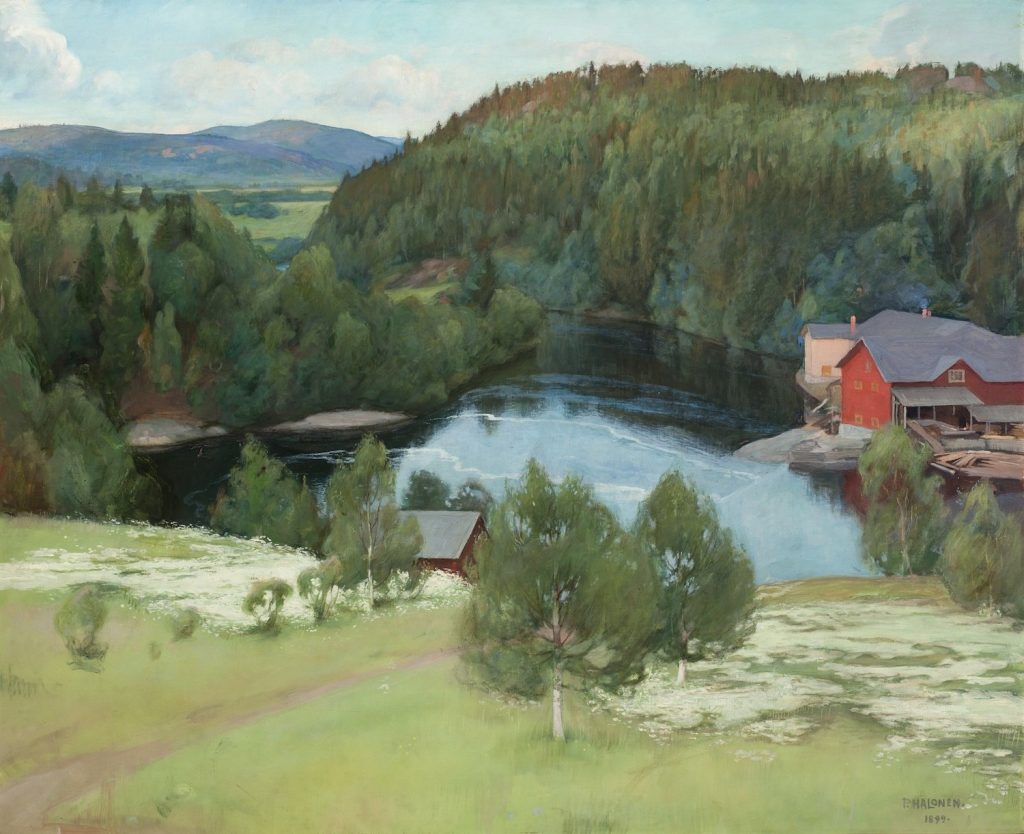Pekka Halonen – Myllykylän saha, 1899
Artis Pekka Halonen’s oil painting Myllykylä sawmill (1899) was purchased for the collection of the Gösta Serlachius Fine Arts Foundation in 1997. The painting depicts a landscape of a place called Myllykylä in the parish of Sortavala. It is in the part of Karelia ceded to the Soviet Union after the Second World War, where the artist’s father-in-law Eero Mäkinen lived. Mäkinen was an entrepreneurial person and a handyman. But he was also a lecturer in craft, drawing and geography at the Sortavala Seminar, the founder of the Myllykylä factories, and the chairman of the town meetings in the parish of Sortavala.
Myllykylä lies just under six kilometres to the north-west of Sortavala. The factory buildings shown in the painting have since been destroyed. In the late 1800s, Myllykylä comprised the main building of the property, Mäkisen Hovi, and E. Mäkinen’s factory and vocational school, constructed in the 1890s.
Myllykylä was a well-known place in Sortavala. The photographer I.K. Inha immortalised the verdant landscape and Mäkinen’s factories in his photographs. Between 1892 and 1923, Pekka Halonen painted about thirty works with Myllykylä as the motif.
The painting Myllykylä sawmill sketches the Tohmajoki (also known as the Helylänjoki), a river which flows from Ruskeala to Lake Ladoga. It softly meanders between the tall, woody hills of Ladoga Karelia. People have driven some logs in front of a sawmill building. You can see on the right the building painted with reddle. In front of the sawmill, at the bottom of the rapids, there is a dyke from where the water falls several metres towards the calm waters.
Before Mäkinen’s time, a flour mill operated at the bottom of the rapids. A waterwheel, mounted in the rapids after 1892, powered not only the flour mill but also the sawmill and the machines of the mechanical carpenters in the carpentry shop.
The rapids ran high in Myllykylä, but people there also fine-tuned harmoniums and Finnish zithers. Originally, Pekka Halonen had arrived in Myllykylä to meet his brother Aapeli who worked in Mäkinen’s harmonium factory. Subsequently Aapeli established his own harmonium works in Jyväskylä.
In addition to musical instruments, E. Mäkinen’s factory manufactured tools and models needed in boys’ craft lessons at comprehensive schools. Myllykylä also housed E. Mäkinen’s Carpentry School where boys’ craft teachers could supplement their skills and study for teacher’s qualifications.
Pekka Halonen was not the only painter at Myllykylä – Helmi, his wife Maija’s sister, married painter Väinö Hämäläinen. The artistic legacy of Myllykylä lives on, as Maija Halonen’s sister Aino’s daughter became the pottery artist Rut Bryk, and her daughter is the artist Maaria Wirkkala.
Myllykylä had a long cultural history even before the Mäkinen family. This was where the artist Venny Soldan-Brofeldt’s father, A.F. Soldan, the director of the Finnish Mint, spent his early childhood. Mäkinen had bought Myllykylä from the well-known art patrons Herman and Elisabeth Hallonblad. They bequeathed their art collection from the 1800s to the Finnish National Gallery.
The factory buildings at Myllykylä burned down in 1912. After that, they transferred the factory to Helylä Oy. It moved the operation from Myllykylä to the village of Helylä, close to better railway connections.
The main building of Myllykylän Hovi, where Pekka Halonen painted Myllykylä sawmill from the porch, was destroyed during the Continuation War. On the forest covered slope across the shore from the Hovi, a few dwellings of the workers at E. Mäkinen’s factory remain. The white flowers on the greens shown in the painting look like cow parsley, but there are probably daisies, which had been planted on the slope.
Marjo-Riitta Simpanen
Curator and art historian


